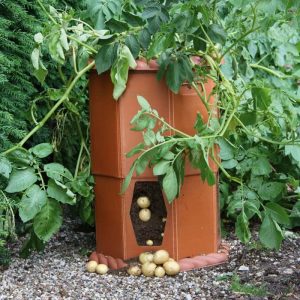Thanks to products such as the potato barrel even those with very limited outdoor space can enjoy some home grown potatoes and taste the difference by patio growing potatoes. Since many stores are selling seed potatoes in small packs of 5 there’s no wasted seed tubers or money.
What varieties to choose for patio growing potatoes
The obvious varieties to grow would be first earlies like Arran Pilot, Swift or Rocket but you might prefer to grow a second early salad variety like Charlotte or Anya. Another good choice for a barrel would be Orla.
Technically Orla is an early maincrop but is often grown as a first early with the benefit of being able to be left to grow on through the season.
Avoid maincrop potatoes as they’re generally not the best for container growing.
Setting Up the Barrel for Patio Growing Potatoes
Choose a sunny spot if at all possible. The more sun the better for growing your potatoes.
I like to place a layer of turf on the base. Ordinary lawn turf taken up the previous year and stacked grass side down is perfect. The mass of roots from the grass holds it together and it acts as a sponge to hold a water reserve.
If you don’t have any turf available add some water-retaining crystals to the compost, even if you have turf it’s not a bad idea.
Next place a layer of multi-purpose compost into which you have mixed some slow release potato fertiliser about 15 to 20cm thick. If you don’t have a specific potato fertiliser; fish, blood & bone is better to use as a fertiliser than Growmore as the nutrients release more slowly.
Additional potash in the form of wood ashes in moderation will help although they can increase the pH and potatoes actually prefer a slightly acid soil with a pH around 5.5
One tip from the show growers to get near-perfect skins on your potatoes is to pass the compost through a shredder to get a fine mixture. It’s worth doing with cheap shop-bought composts that tend to have twigs and bits of wood in.
Incidentally, be careful with cheap composts, I’ve found broken glass in one sack. Generally I think it’s well worth spending a bit extra for a decent compost.
If you don’t buy in multi-purpose compost then you can mix your own with home-made compost, sifted garden soil and leafmould. Leafmould and Russian comfrey leaves provides both growing medium and additional potash to aid growth. Do not add lime to the compost.
Lay the tubers on, eyes upwards if not already chitted and cover with another 15 to 20cm layer of compost.
Once the leaves start to show about 20cm (8″) above the surface, add some more compost to half-way up the leaves. Keep repeating as the haulm grows, adding the compost slowly, layer by layer, until you get to the top of the barrel.
It’s critical to keep watering, potatoes like a lot of water. You don’t want the compost soaking wet but moist all through. Adding water retaining granules to the compost (often used in hanging baskets) will help no end, especially if you go away for a few days.
If you can, use rainwater from a water butt rather than tap water. Tap water often has a neutral to high pH (alkaline) and potatoes prefer to grow in somewhat acid soil with a pH of 5.5 against the 6.5 / 7.0 preferred by most of our vegetables. In more alkaline soils they often develop scab which is very unattractive in new or salad potatoes.
Additional Fertiliser
Harvesting Patio Potatoes
Once the plants flower which is the indicator that the tubers are forming and probably ready, you can open the side of the barrel and start removing potatoes, meal by meal, leaving the rest to grow on.
Once the potatoes are all gone you can re-use the compost as a soil improver or for container growing flowers or other vegetables.
Potato Growing Articles
- Growing Potatoes Overview – How to Grow Potatoes Guide
- How Many Seed Potatoes are Needed
- Potato Flowers, Fruits, Seeds & Breeding
- Growing Potatoes – Standard Traditional Method
- Growing Potatoes Under Straw Mulch
- Growing Potatoes Under Black Plastic (Polythene) Sheet
- Potato Growing in Raised Beds & Ridge Planting Potatoes
- Growing Potatoes in a Barrel – Patio Growing Potatoes
- Growing Potatoes in Bags | Greenhouse Potatoes
- Second Crop Autumn Planted Christmas New Potatoes
- Can you chit supermarket potatoes?
- Potato Varieties for Flavour -Boiled Baked Roasted Mashed
- Potato Fertiliser Program Program & (NPK) Requirements
- Potato Blight Cause, Identification. Prevention, Treatment Potato Blight
- Wireworm in Potatoes Cause Identification Prevention Control Potato Wireworm
- Eelworm Potato Cyst Nematode – Control Potato Eelworm
- Dry Rot in Potatoes Cause Identification Prevention Control of Potato Dry Rot
- Potato Scab – Common Scab in Potatoes
- Potato Scab – Powdery Scab in Potatoes
- Hollow Heart, Splitting & Spraing Potatoes
- White Spots on Potatoes Lenticels & Potato Stem Rot
See Also:
- Growing Potatoes for Show, Introduction & Best Varieties
- Growing Potatoes for Show, Cultivation of Show Potatoes
- Growing Potatoes for Show Harvest & Showing Potatoes




